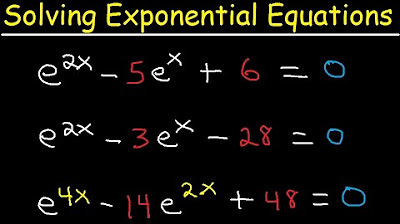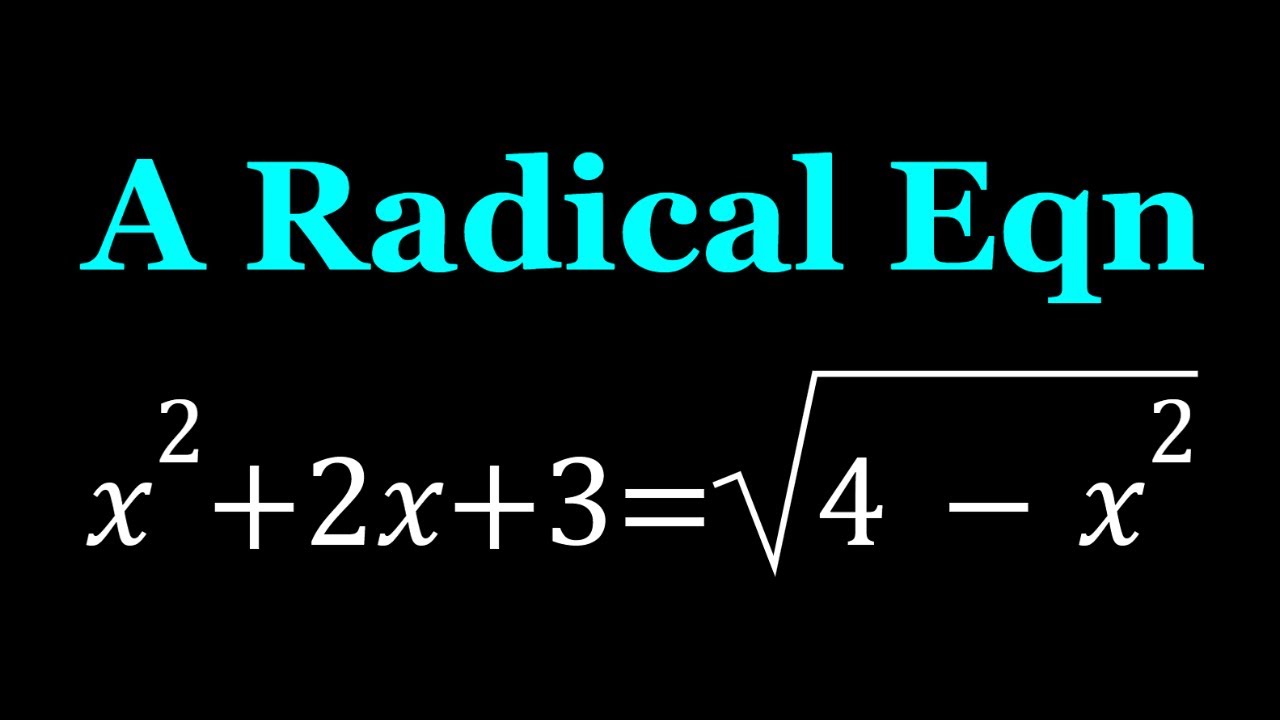The Algebra Step that EVERYONE Gets WRONG!
TLDRIn this instructional video, math teacher John addresses a common mistake made by students when solving algebraic equations involving square roots. He emphasizes the critical step of checking solutions for extraneous roots, which can arise when both sides of an equation are squared. John demonstrates the correct method for solving the given equation and highlights the importance of using the principal square root when checking solutions, ultimately revealing that the provided equation has no solution.
Takeaways
- 📚 The video discusses a common mistake made by students when solving algebraic equations, emphasizing the importance of understanding a critical step to avoid errors.
- 🔢 The problem presented is 3 - √(2m + 2) = 8, where the goal is to solve for the variable M.
- ✅ The correct answer to the problem is that there is no solution, which indicates a good understanding of the algebraic process involved.
- 💡 The video introduces the concept of a 'radical equation' and explains that the initial goal is to isolate the radical on one side of the equation.
- 📈 To eliminate the square root, the video advises squaring both sides of the equation, which helps to remove the radical.
- 🚫 The video warns about the potential introduction of 'extraneous solutions' when squaring both sides of an equation involving a variable.
- 🔄 It is crucial to check the solution back into the original equation to verify its validity and avoid falling for the trap of extraneous solutions.
- 🛑 The video clarifies the misunderstanding around the square root of 25, explaining that the principal square root (positive value) should be used, not the negative.
- 🎓 The speaker, John, is an experienced math teacher who aims to make math learning easier and offers various math courses through his website.
- 📌 The video serves as a reminder that a good grasp of algebraic concepts is essential and that common pitfalls can lead to incorrect solutions.
- 👍 The video encourages viewers to subscribe and engage with the content for further assistance in mathematics.
Q & A
What is the main issue that students often get wrong when solving algebraic equations?
-The main issue students often get wrong is not understanding the critical step of checking their answer in the original equation, which can lead to accepting extraneous solutions that do not actually satisfy the original equation.
What type of equation is being discussed in the transcript?
-The equation being discussed is a radical equation involving a square root.
What is the initial goal when solving a radical equation?
-The initial goal when solving a radical equation is to get the radical or square root on one side of the equation and a single number on the other side.
What is the significance of squaring both sides of an equation with a radical?
-Squaring both sides of an equation with a radical eliminates the square root, leaving you with the variable underneath the radical, which simplifies the equation.
What is an extraneous solution in the context of algebra?
-An extraneous solution is a solution that may arise when you perform operations like squaring both sides of an equation, which is not actually a valid solution to the original equation.
How can you determine if a solution is extraneous?
-To determine if a solution is extraneous, you should check the solution by substituting it back into the original equation and see if both sides are equal. If they are not, the solution is extraneous.
What is the principal square root, and why is it important in this context?
-The principal square root is the non-negative (positive) square root of a number. It is important in this context because when checking solutions, you only use the principal square root unless the context (like a quadratic equation) explicitly requires both positive and negative roots.
What is the correct answer to the equation 3 - √(2m + 2) = 8?
-There is no solution to the equation 3 - √(2m + 2) = 8.
Why does the video emphasize the importance of checking the solution in the original equation?
-Checking the solution in the original equation is emphasized because it is a necessary step to ensure that the solution does not introduce extraneous roots and is indeed a valid solution to the original problem.
What is the role of the arithmetic square root symbol (√) in the equation?
-The arithmetic square root symbol (√) represents the principal square root, which is the non-negative square root of a number. It is used to find the positive root when solving the equation.
How does the video instructor help students avoid common mistakes in algebra?
-The video instructor helps students avoid common mistakes by explaining the concept of extraneous solutions, emphasizing the importance of checking solutions in the original equation, and providing a step-by-step walkthrough of solving the given radical equation.
Outlines
📘 Introduction to Solving Algebraic Equations
The paragraph introduces the common mistake students make when solving algebraic equations, emphasizing the importance of understanding a critical step to avoid errors. The speaker, John, a mathematics teacher with decades of experience, presents a problem involving the variable M and encourages viewers to participate. He mentions his math program and the importance of checking solutions against the original equation to avoid extraneous solutions, setting the stage for a detailed explanation of solving radical equations.
🔍 Identifying Extraneous Solutions in Algebra
This paragraph delves into the concept of extraneous solutions, which can arise when squaring both sides of an equation involving a variable. The speaker explains that such solutions may not be valid for the original equation and illustrates this with an example. He emphasizes the necessity of checking the solution against the original equation to confirm its validity, highlighting the common pitfalls in algebra that lead to incorrect answers.
📐 Understanding Principal Square Roots in Algebra
The speaker clarifies the concept of principal square roots, which are the positive roots when taking the square root of a number. He corrects the common misconception that the square root of a number can be both positive and negative, explaining that in the context of the given problem, only the positive root is applicable. The paragraph aims to dispel confusion around square roots and their application in algebraic equations, reinforcing the importance of using the correct value when checking solutions.
🚫 Addressing Common Errors and Encouraging Subscription
In the final paragraph, the speaker addresses the common errors made by students when solving the given algebraic problem and reiterates that there is no solution, despite the misleading result with the negative square root. He encourages viewers to subscribe to his channel for more educational content and mentions his various math courses for different levels of learners. The speaker concludes by wishing viewers well in their mathematical endeavors and thanks them for their time.
Mindmap
Keywords
💡Algebra
💡Radical Equation
💡Extraneous Solutions
💡Principal Square Root
💡Substitution
💡Mathematics Education
💡Mathematical Analysis
💡Critical Thinking
💡Mathematics Terminology
💡Online Learning Resources
Highlights
The transcript discusses a common mistake made by students when solving algebraic equations, emphasizing the importance of understanding a critical step to avoid errors.
The problem presented involves solving an equation with a variable M, where 3 - √(2m + 2) = 8, and encourages the audience to attempt the problem before revealing the solution.
The correct answer to the problem is revealed to be that there is no solution, highlighting the concept of a 'null' or 'empty set' in mathematics.
The speaker, John, introduces himself as a math teacher with decades of experience and emphasizes his passion for making math learning as easy as possible.
The transcript explains the process of solving radical equations, including the goal of isolating the radical on one side of the equation and the method of squaring both sides to eliminate it.
A critical step in algebra is introduced, which involves checking the solution back into the original equation to ensure its validity, a step often overlooked by students.
The concept of extraneous solutions is introduced, explaining that squaring both sides of an equation with a variable can introduce solutions that are not valid for the original equation.
The transcript provides a clear example of how to check a solution by plugging it back into the original equation to verify if it holds true.
The speaker clarifies the difference between the principal square root and the two solutions (positive and negative) that arise when solving quadratic equations.
The transcript emphasizes the importance of using the principal square root when checking solutions, which is the positive version of the number, not the negative.
The final check of the solution m = 23/2 leads to a false statement, confirming that there is no solution to the original equation.
The speaker encourages students to be confident in their understanding of extraneous roots and to trust their math teachers' guidance.
The transcript concludes by encouraging the audience to like and subscribe to the channel for more math content and to check out John's math courses for further assistance.
Transcripts
Browse More Related Video

Solve: the square root of (3x) = – 7 don’t make this common error!

Watch me solve this Rational Equation – step-by-step

Quadratic Formula – MOST COMMON MISTAKES!

Solving Exponential Equations In Quadratic Form - Using Logarithms, With e

Using Substitutions to Solve Equations (Precalculus - College Algebra 23)

A Cool Radical Equation | Math Olympiads
5.0 / 5 (0 votes)
Thanks for rating: